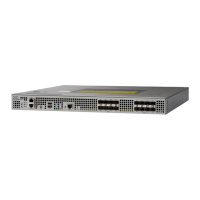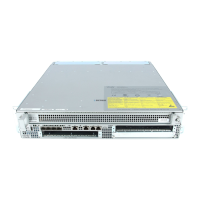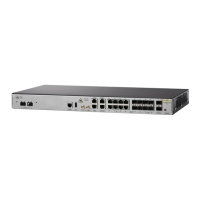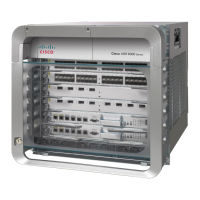High Availability Overview
Route Processor Redundancy
5
Cisco ASR 1000 Series Aggregation Services Routers Software Configuration Guide
ISSU cannot be used to upgrade consolidated packages on Cisco ASR 1002 or 1004 Routers, and only
a few subpackages can be upgraded individually using ISSU through the use of dual IOS processes on
the same Route Processor. See the “Route Processor Redundancy” section on page 5 for more
information on which subpackages can be upgraded using ISSU in a dual RP setup.
Route Processor Redundancy
Route Processor Redundancy (RPR) allows you to configure a standby RP. When you configure RPR,
the standby RP loads the Cisco IOS software on bootup and initializes itself in standby mode. In the
event of a fatal error on the active RP, the system switches to the standby RP, which reinitializes itself
as the active RP. In this event, the entire system is rebooted, so the switchover with RPR is slower than
with other High Availability switchover features such as Nonstop Forwarding/Stateful
Switchover (NSF/SSO).
On the Cisco ASR 1000 Series Router, R
PR can also be used to enable a second IOS process on a single
RP for a Cisco ASR 1002 or 1004 Router. See the “Second IOS Process on a Cisco ASR 1002 or 1004
Router” section on page 4 for additional information o
n the second IOS process.
For the Cisco ASR 1000 Series Routers, RPR introduces the following functionality:
• Startup configuration synchronization between the active and standby RP or IOS process. It is
important to note, however, that changes in the running configuration are not synchronized using
RPR.
• Warm Reload—The Warm Reload feature allows users to reload their routers without reading
images from storage; that is, the router reboots by restoring the read-write data from a previously
saved copy in the RAM and by starting execution without either copying the software from flash to
RAM or self-decompression of the image.
It is important to note that in most cases, Stateful Switchover (SSO) requires less downtime for
swi
tchover and upgrades than RPR. RPR should only be used when there is a compelling reason to not
use SSO.
It is important to note RPR is supported on the Cisco ASR 1000 Series Routers while RPR+ is not.
Stateful Switchover
The Stateful Switchover (SSO) feature takes advantage of processor redundancy by establishing one of
the processors as the active processor while the other RP is designated as the standby processor, and then
synchronizing critical state information between them. Following an initial synchronization between the
two processors, SSO dynamically maintains RP state information between the dual processors.
Stateful Switchover is particularly useful in conjun
ction with Nonstop Forwarding. SSO allows the dual
processors to maintain state at all times, and Nonstop Forwarding lets a switchover happen seamlessly
when a switchover occurs.
Ta b l e 16 Software Redundancy Options for Cisco ASR 1002 and 1004 Routers
Router
Default HA
S
etting
Options with 2 GB or
DRAM
Options with 4 GB or
DRAM
Cisco ASR 1002 Router None None None, RPR, SSO
Cisco ASR 1004 Router None None None, RPR, SSO

